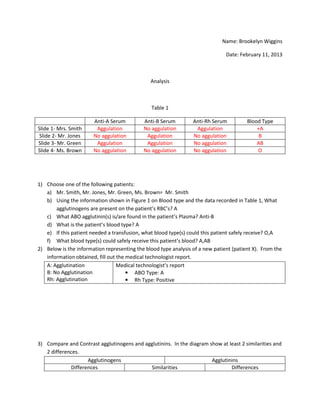
Blood typing lab
- 1. Name: Brookelyn Wiggins Date: February 11, 2013 Analysis Table 1 Anti-A Serum Anti-B Serum Anti-Rh Serum Blood Type Slide 1- Mrs. Smith Aggulation No aggulation Aggulation +A Slide 2- Mr. Jones No aggulation Aggulation No aggulation B Slide 3- Mr. Green Aggulation Aggulation No aggulation AB Slide 4- Ms. Brown No aggulation No aggulation No aggulation O 1) Choose one of the following patients: a) Mr. Smith, Mr. Jones, Mr. Green, Ms. Brown= Mr. Smith b) Using the information shown in Figure 1 on Blood type and the data recorded in Table 1, What agglutinogens are present on the patient’s RBC’s? A c) What ABO agglutinin(s) is/are found in the patient’s Plasma? Anti-B d) What is the patient’s blood type? A e) If this patient needed a transfusion, what blood type(s) could this patient safely receive? O,A f) What blood type(s) could safely receive this patient’s blood? A,AB 2) Below is the information representing the blood type analysis of a new patient (patient X). From the information obtained, fill out the medical technologist report. A: Agglutination Medical technologist’s report B: No Agglutination • ABO Type: A Rh: Agglutination • Rh Type: Positive 3) Compare and Contrast agglutinogens and agglutinins. In the diagram show at least 2 similarities and 2 differences. Agglutinogens Agglutinins Differences Similarities Differences
- 2. Found on surface of Produced in blood, part of found in plasma, production is erthrocytes, blood type is immune system initiated by amount of A and B based on antigens that enter the body 4) Pretend you went with your class on a medical career field trip to a local hospital. One of the stops on the visit was to the hospital’s blood lab. The medical technologist at this stop gave a demonstration of how blood types are determined. Your job is to write a paragraph for the school newspaper on the visit to the blood lab, summarizing what you’ve learned about how ABO/Rh blood groups are determined. Write a paragraph and include the title. THE ANATOMY OF BLOOD TYPING:There are four blood types A, B, AB, and O. A persons blood type is determined by the presence or absence of aggulutinogens, or antigens. Someone with A antigens has anti-B antibodies, and a person with B antigens has anti-A antibodies. A person who does not have A or B antigens has both anti-A and anti-B antibodies. Someone with both A and B antigens doesn’t have anti-A nor anti-B antibodies. This means that blood type is based on the antigens, not the antibodies. Your body can receive transfusions of only certain blood types, depending on the type of blood they have; if incompatible blood types are mixed agglutinaton occurs. Landsteiner and Wiener discovered that rabbit sera containing antibodies for the red blood cells of the Rhesus monkey would agglutinate the red blood cells of 5% of Caucasians. Individuals who possess these antigens are designated Rh+ and those who do not possess these antigens are designated Rh-. 5) List at least 3 situations where blood typing could be used. a) Blood transfusions b) Criminal Investigation c) Paternity test 6) Define Erythroblastosis Fetalis. Hemolytic disease of the newborn is a blood disorder in a fetus or newborn. It’s a diease that can be extremely life threatening. a) Describe the sequence of events that lead to this condition. A mother and her unborn baby have incompatable blood types. Basically, the mother is producing antibodies that attack the baby’s red blood cells. b) What might be some benefits if the medical profession developed a shot or vaccination that could desensitize an Rh+ situation? There would be no risk,nothing would happen to the fetus. 7) You are a type A eryhthorocyte placing an ad in the personals and you are seeking a compatible mate for a long lasting transfusion. Create an ad to be submitted to the newspaper. I am a TYPE A looking for TYPE A/O. I am red blooded and just looking for that special cell to share a long lasting transfusion with. 8) Another important diagnostic tool used by medical technologist is determining a patient’s blood cell count, for both red blood cells and white blood cells. When this procedure is performed, one technique used is to take multiple samples and calculate the average. This method of multiple sampling is a standard procedure in scientific and medical investigations. Discuss why this method is
- 3. important in blood typing. It is important to take multiple samples to confirm the results and reduce the risk of human error. 9) Each year thousands of people contract blood borne diseases. What could be done in a clinical blood lab to minimize the risk of obtaining or spreading a blood borne disease? You’re your hands often, wear personal protective clothing (gloves, goggles, gowns, masks), and sanitize contaminated equipment used in clinical blood lab (2). 10) In a short paragraph, identify what you think may be the next important breakthrough, milestone or discovery in the study of blood and blood diseases and explain why. If a synthetic blood substitue was created, those who needed blood in emergency situations would not have to wait for compatible blood type, or a blood resource to be transported to them.
